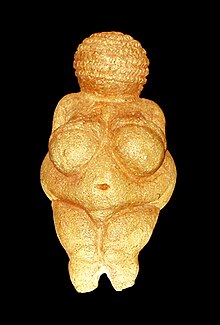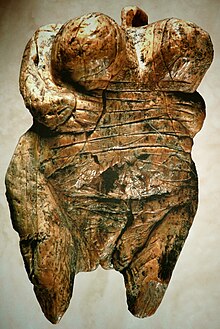
Back تمثال فينوس المصغر Arabic Lekeraporugalafa kudjotya AVK Палеалітычная Венера Byelorussian Палеолитна Венера Bulgarian Venus prehistòrica Catalan Venuše (figurka) Czech Venusfigurine Danish Venusfigurinen German Παλαιολιθικό ειδώλιο Αφροδίτης Greek Venusfiguroj Esperanto


A Venus figurine is any Upper Palaeolithic statue portraying a woman, usually carved in the round.[1] Most have been unearthed in Europe, but others have been found as far away as Siberia and distributed across much of Eurasia.
Most date from the Gravettian period (26,000–21,000 years ago).[1] However, findings are not limited to this period; for example, the Venus of Hohle Fels dates back at least 35,000 years to the Aurignacian era, and the Venus of Monruz dates back about 11,000 years to the Magdalenian. Such figurines were carved from soft stone (such as steatite, calcite or limestone), bone or ivory, or formed of clay and fired. The latter are among the oldest ceramics known to historians. In total, over 200 such figurines are known;[2] virtually all of modest size, between about 3 and 40 cm (1.2 and 15.7 in) in height.[3] These figurines are recognised as some of the earliest works of prehistoric art.
Most have wide hips and legs that taper to a point. Arms and feet are often absent, and the head is usually small and faceless. Various figurines exaggerate the abdomen, hips, breasts, thighs, or vulva, although many found examples do not reflect these typical characteristics. Depictions of hairstyles can be detailed, and clothing or tattoos may be indicated.[4]
The original cultural meaning and purpose of these artefacts is not known. It has frequently been suggested that they may have served a ritual or symbolic function. There are widely varying and speculative interpretations of their use or meaning: they have been seen as religious figures,[5] an expression of health and fertility, grandmother goddesses, or as self-depictions by female artists.[6]
- ^ a b Fagan, Brian M., Beck, Charlotte, "Venus Figurines", The Oxford Companion to Archaeology, 1996, Oxford University Press, ISBN 9780195076189 pp. 740–741
- ^ Holloway
- ^ Fagan, 740
- ^ "Clothing of figurines may be record of Ice Age tribes' skills". old.post-gazette.com. Archived from the original on 2021-01-21. Retrieved 2019-11-13.
- ^ Beck, 207-208
- ^ William Haviland, Harald Prins, Dana Walrath, Bunny McBride, Anthropology: The Human Challenge, 13th edition, 2010, Cengage Learning, ISBN 0495810843, 9780495810841,google books; Cook; Beck, 205-208